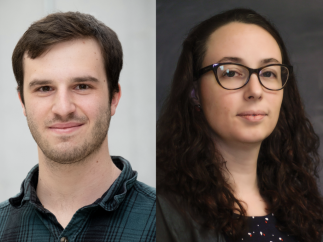Thermal transport study in the Kitaev spin liquid candidate RuCl3
Etienne Lefrançois
Département de physique
Université de Sherbrooke
Présentation en anglais
Lien Zoom: https://umontreal.zoom.us/j/93026432919
Meeting ID: 930 2643 2919
Passcode: écrire en chiffre: un, trois, sept.
Abstract: The material a-RuCl3 has been extensively researched as a potential candidate for Kitaev quantum spin liquid, whose low-energy excitations are expected to be Majorana fermions. Note that a-RuCl3 orders antiferromagnetically at low temperature, under TN = 7 K, but an external magnetic field in the plane, greater than H|| = 7 T, removes this order. The question is whether or not there is, over a range of fields greater than 7 T, an orderless region that harbours a liquid state of quantum spin. The recent announcement of a quantized thermal Hall conductivity at H|| > 7 T by Kasahara et al. [Kasahara et al., Nature 559, 227 (2018)] would be the first direct evidence of itinerant Majorana fermions in a quantum spin liquid state. In the study we present here, we examine the origin of thermal Hall conductivity kxy in a-RuCl3. The comparison between the longitudinal thermal conductivity kxx and kxy suggests that the thermal Hall conductivity signal is mainly dominated by phonons - questioning the possibility of a quantified kxy. In addition, depending on the H|| field, we do not see an intermediate region between the antiferromagnetic state under 7 T and the state of polarized spins at strong field, thus leaving little room for a quantum spin liquid state.
========================
Predominance of non-adiabatic effects in the zero-point renormalization of the band gap: connecting first-principles approach and the Fröhlich model
Véronique Brousseau-Couture
Département de physique
Université de Montréal
Présentation en anglais
Lien Zoom: https://umontreal.zoom.us/j/93026432919
Meeting ID: 930 2643 2919
Passcode: écrire en chiffre: un, trois, sept.
Abstract: Electronic and optical properties of materials are affected by atomic motion through the electron-phonon interaction. As a consequence, band gaps acquire a temperature dependence, and are affected even at absolute zero temperature, where the zero-point motion of the ions causes zero-point renormalization (ZPR) of the band gap. From a first-principles point of view, different methodologies have been used throughout the literature to compute the ZPR, relying on different approximation schemes. One of the most widely used is the adiabatic approximation, which supposes that the electrons adjust instantaneously to the periodic modulation of the crystal potential created by phonons. I will present numerical results for the ZPR of 30 materials, and show that global agreement with available experimental data is obtained only when non-adiabatic effects are taken into account. I will then demonstrate that these effects dominate the ZPR for many materials, by introducing a generalized Fröhlich model that accounts for multiple phonon branches, as well as anisotropic and degenerate band extrema. I will finally address the physical mechanism that is brought to light by these results.
Cette conférence est présentée par le RQMP.

